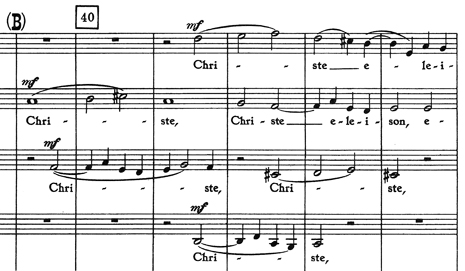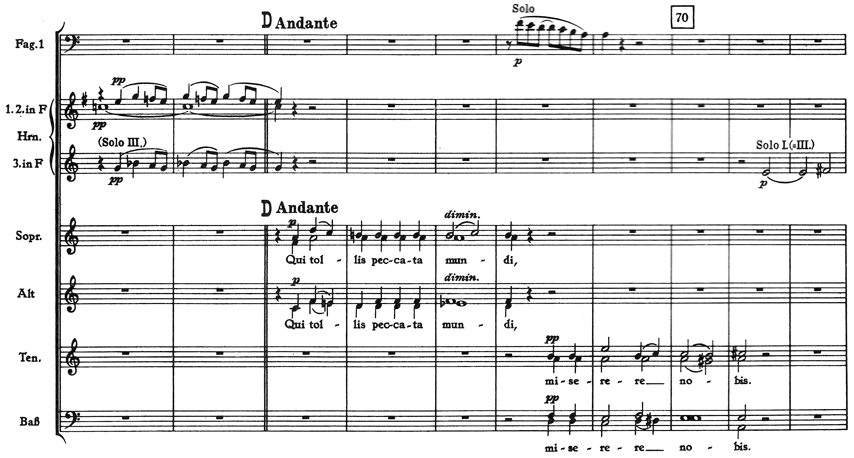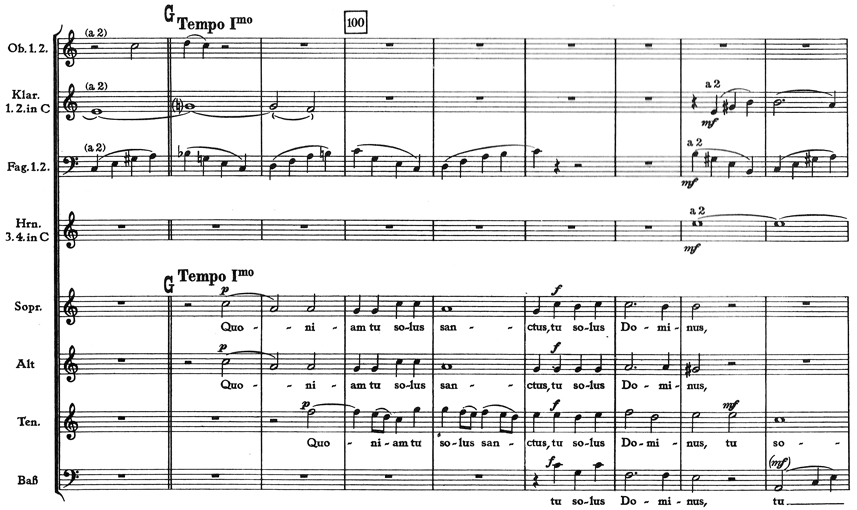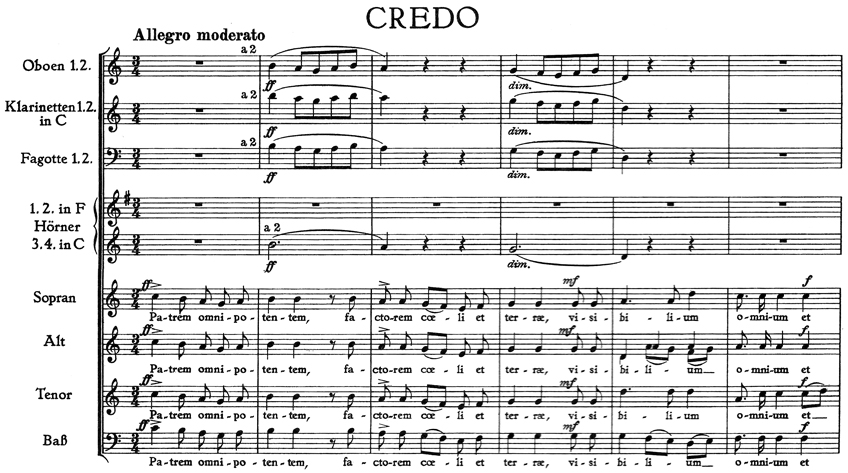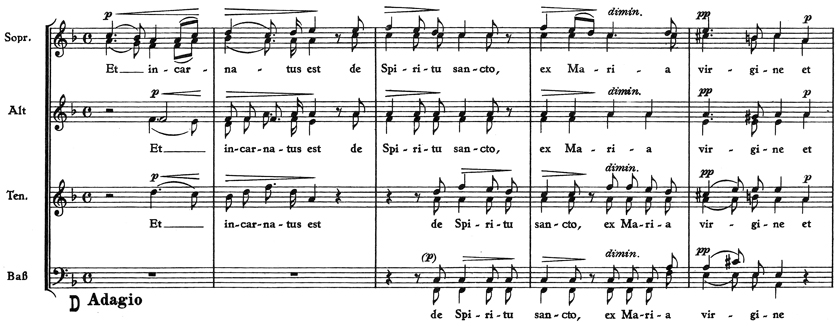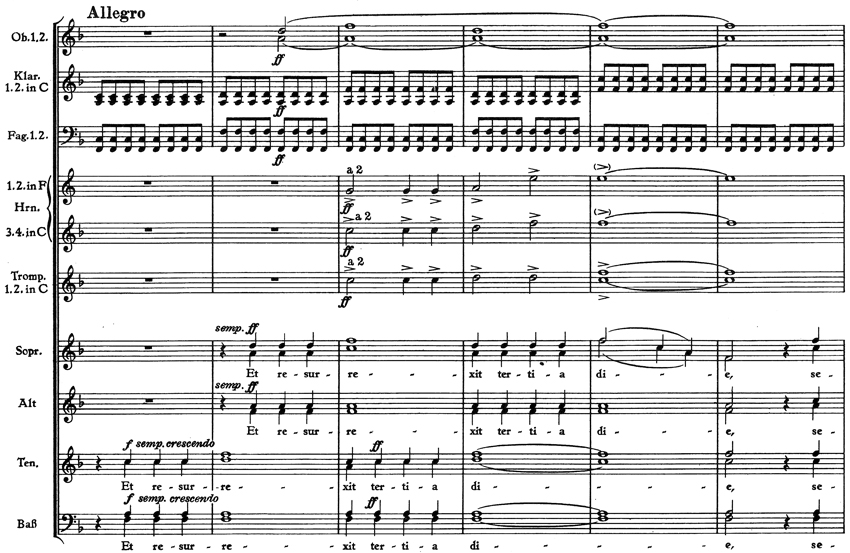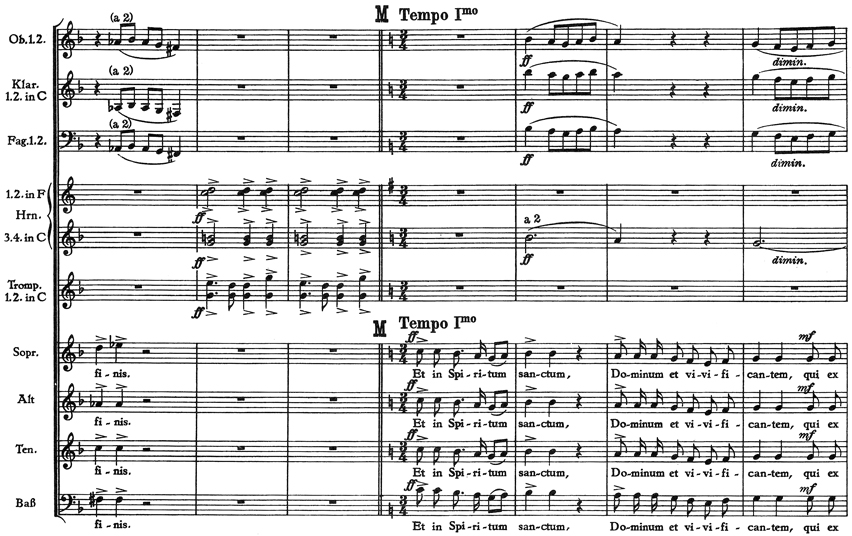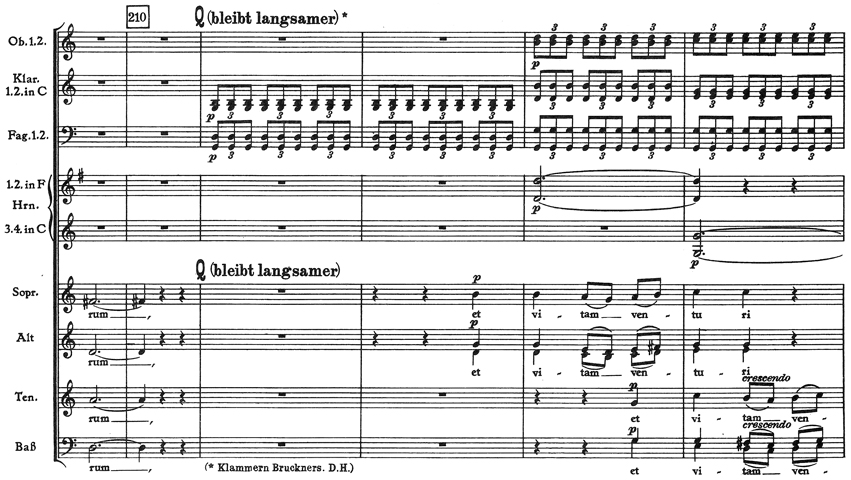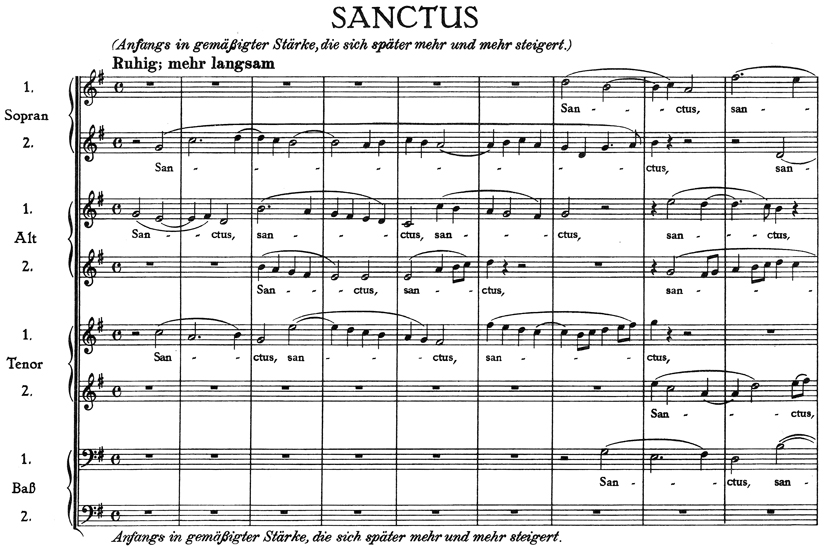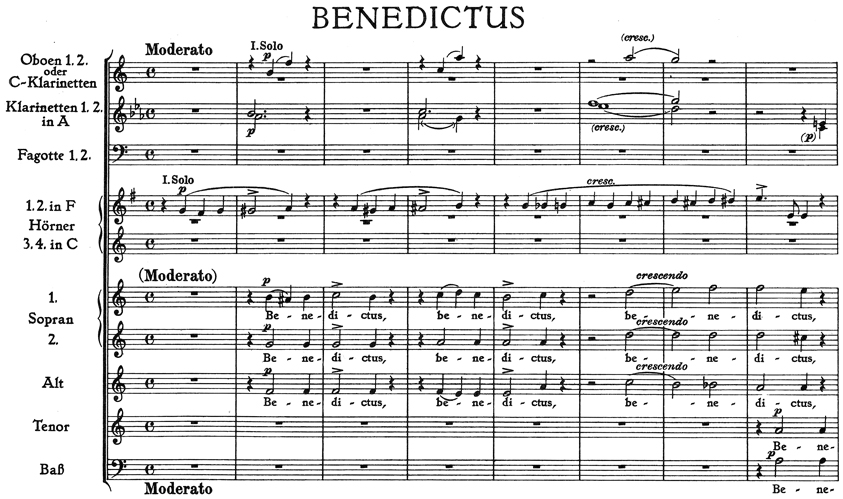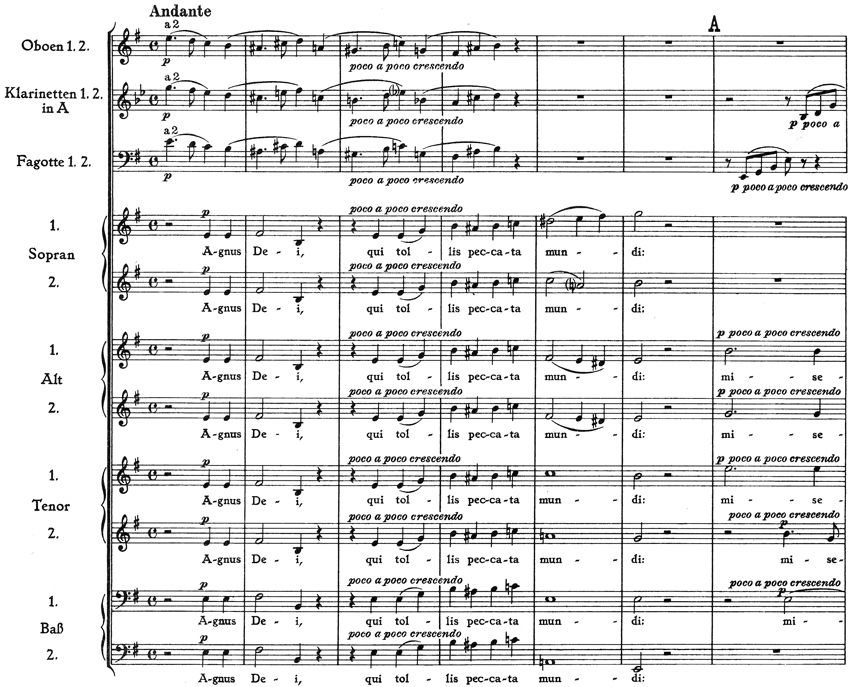Anton Bruckner
Mass No.2 in E minor, WAB 27
Media Review / Comparison
2015-06-16 — Original posting
2016-08-04 — Brushed up for better readability
Table of Contents
- Introduction / The Recordings
- Background, About the Composition
- The Movements
- The Interpretations, Overview
- The Interpretations, Detail
- Eugen Jochum , Chor des Bayerischen Rundfunks, Bläser des Symphonieorchesters des Bayerischen Rundfunks (1971)
- Daniel Barenboim , John Alldis Choir, English Chamber Orchestra (1974)
- Philippe Herreweghe , La Chapelle Royale & Collegium Vocale, Ensemble Musique Oblique (1989)
- Simon Halsey , CBSO Chorus, CBSO Wind Ensemble (1990)
- Helmuth Rilling , Gächinger Kantorei Stuttgart, Bach-Collegium Stuttgart (1996)
- Stephen Layton , Polyphony, Britten Sinfonia (2007)
- Addendum 1
- Addendum 2
Introduction / The Recordings
This posting is about Anton Bruckner‘s Mass No.2 in E minor for double choir and wind ensemble (WAB 27), of which I currently have the following 6 recordings, sorted by the conductor’s last name:
- Daniel Barenboim, John Alldis Choir, English Chamber Orchestra (1974)
- Simon Halsey, CBSO Chorus, CBSO Wind Ensemble (1990)
- Philippe Herreweghe, La Chapelle Royale & Collegium Vocale, Ensemble Musique Oblique (1989)
- Eugen Jochum, Chor des Bayerischen Rundfunks, Bläser des Symphonieorchesters des Bayerischen Rundfunks (1971)
- Stephen Layton, Polyphony, Britten Sinfonia (2007)
- Helmuth Rilling, Gächinger Kantorei Stuttgart, Bach-Collegium Stuttgart (1996)
The Jochum recording was the only one in my LP collection. The others are more recent additions, in order to have a variety of interpretations for comparison. By comparing multiple recordings, one not only gets a broader scope, but one also learns / tends to listen more carefully, which typically yields additional insights.
Background, About the Composition
Anton Bruckner (1824 – 1896) wrote his Mass No.2 in E minor (WAB 27) in 1866, for the inauguration of a chapel in the newly built cathedral in Linz. Due to a delay in the construction, the inauguration, and hence the first performance of the first version of this mass only took place in 1869. Bruckner already made some first revisions for that first performance, further revisions took place 1876 and 1882.
Most performances today (and all of the recordings discussed below) are based on the last (“second”) version of 1882, published by the International Anton Bruckner Society in Vienna in 1959, under the supervision of Leopold Nowak. The composition is for 8-part mixed choir and wind ensemble (2 oboes, 2 clarinets, 2 bassoons, 4 horns, 2 trumpets and 3 trombones). Note that the section below show only fragmentary excerpts from the score. Empty and secondary voices have typically been removed, also some duplicate annotations, etc.
The Movements
Formally, this is a missa brevis (i.e., a mass often restricted to a single reading of the liturgical text, and, more importantly, a mass that suits the catholic ordinarium, i.e., can be performed as part of a service). The sections according follow the Roman catholic rites, i.e., Kyrie — Gloria — Credo — Sanctus — Benedictus — Agnus Dei:
I. Kyrie: Feierlich (4/4)
117 bars
The Kyrie (Kyrie eleison — Christe eleison — Kyrie eleison) looks like alla breve (2/2) — but Bruckner annotated Solemn and 4/4. He even added an explicit remark “to be taken quite 4/4”, i.e., to be taken in 4 beats per bar, and hence fairly slow. To the point where the conductors of the first performances stated “Sorry, I can’t take this any slower, otherwise the intonation is going to suffer.”:
The main problem with the intonation is that the first 10 bars are a cappella, i.e., without instrumental accompaniment. Major stretches throughout this section (up to 30 bars in the Christe) are also a cappella. After these choral sections, instrumental fanfares set in (horns in the first Kyrie, trombones at the end of the Christe eleison, trombones and horns in the second Kyrie). With a slow tempo, the choirs will inevitably drift, and this will be very obvious when the wind instruments join in. Some live interpretations may resort to adding an organ colla parte in order to avoid tonal drift. If this is the case, it should be done such that the organ is not heard in the audience. Not prominently, at least. There are no provisions for such an option in the score.
The first Kyrie changes between 4-part female and 4-part male sections, the remainder of the section is 8-part polyphonic, except for the last 25 bars, which are 4-part homophonic. Bruckner is very demanding on the singers. The soprano part extends to a”, the tenor part even to b’. And of course, the idea is that this is not performed with falsetto voice!
II. Gloria: Allegro (4/4) — Andante — Tempo I
193 bars
The words “Gloria in excelsis Deo” are not part of the score. It is to be intoned by a priest (in a service) or a soloist (in a concert or a recording). The choice of Gregorian intonation may differ, depending on local traditions. Given Catholic rites, this must be a male voice (tenor, baritone or bass) — I personally think it should be clean, but not too operatic / artful / dramatic: just like a typical (good) priest in a service. In this comparison, three Gregorian versions are used:
- Barenboim, Herreweghe, and Rilling use the same source
- Jochum and Layton use another source, but different in height
- Halsey uses a source that is closely related to Jochum’s / Layton’s
The initial Allegro part is mostly for 4-part choir and switches between homophonic and polyphonic (imitated / canon-like) segments. After the initial bars shown below, the full set of wind instruments forms a rich accompaniment, with bassoons and clarinets (occasionally also oboes) playing waves of crotchets:
Qui tollis
Bruckner does not specify metronome numbers, so all we have is the composer’s symbolic annotation. My take from this is that the Allegro part should feel (somewhat) joyful (= allegro). It does not help to stick to a convention such as a metronome number typically associated with Allegro: if we were to follow the book, an Allegro in 4/4 ought to be played at 1/4=120-168. Rilling sticks to this convention (1/4=132). But as the notation makes the music feel like alla breve (2/2), the result is rather static, as one tends to hear 1/2=66.
A 4-bar ritardando leads into the Qui tollis peccata mundi, annotated Andante (still formally 4/4):
After 29 bars, and after “miserere nobis“, a poco a poco accelerando leads back to the initial tempo, for the “Quoniam tu solus sanctus“:
III. Credo: Allegro moderato (3/4) — Adagio (4/4) — Allegro — Tempo I (3/4) — Etwas langsamer
225 bars
Also here, the initial phrase, “Credo in unum Deum“, needs to be intoned by a priest or soloist. In this comparison, two Gregorian versions are sung:
- Jochum, Halsey, Herreweghe, and Rilling use the same source
- Barenboim and Layton use another source
The choir then starts with “Patrem omnipotentem“, written in 3/4, annotated Allegro moderato. That entire section is homophonic, for 4-part choir, partly even in unison, and also the accompaniment is homophonic (often responding to the choir), and often with voices playing in parallel:
After the “descendit de coelis“, 6 bars (ending in a 2-bar ritardando) lead over to an Adagio (4/4), a section for 8-part choir, with longer stretches a cappella, and very, very tricky in intonation, e.g.: the two “et homo factus est” for single-voice bass, very slow, reaching down to contra-F and contra-E♭, or even just the two “passus” in bars 83/84):
Et resurrexit
After the “passus“, the “et sepultus est“, a very solemn, touching moment, is for four voices a capella, followed by an equally solemn and touching response by horn and the trombones. Thereafter, the woodwinds start repeated quavers (Allegro, still 4/4), into which the choir (8 voices) joins in, alternating between male and female voices, with “Et resurrexit“:
at the end of this section (“non erit finis“), brass fanfares lead over to the original tempo (Tempo I), again in 4/4:
Et in vitam venturi saeculi, Amen
After a joyful “resurrectionem“, in unison and fff, the “mortuorum” is annotated “Etwas langsamer” (somewhat slower). That’s almost a euphemism, given that in the most moderate case (Jochum) the tempo goes from 1/4=94 to 1/4=60, or at the other extreme (Barenboim) from 1/4=116 to 1/4=42!
The last 15 bars are annotated “(bleibt langsamer)” (stays slower, parentheses by Bruckner). The accompaniment is dominated by quaver triplets in the woodwinds, mostly resting notes (also colla parte voices) in the brass section, while the choir has an overwhelming build-up from p to a jubilant, reassuring fff for the “et vitam venturi saeculi. Amen, amen, amen“. Bruckner’s deepest conviction, for sure!
IV. Sanctus: Ruhig, mehr langsam (4/4)
51 bars
Also here, as in the Kyrie, Bruckner explicitly stated “to be taken quite 4/4”, i.e., not to be performed with two beats per bar only, and the annotation is “Calm, more (like) slow“. There is no standard dynamic annotation at the beginning, but a statement “Initially with moderate strength, which later gains force more and more”: the first part is all a cappella, for 8-part choir — not a fugue, but with voices imitating each other in a steady flow of growing intensity:
By the time the brass instruments set in (fff, in bar 27), the choir must have reached fff, too. The second part (up to bar 51) is all homophonic in the choir. Initially, the brass instruments are colla parte with the choir, then the woodwinds take over the colla parte playing for 9 bars, while the brass accompaniment takes up the imitative polyphony of the beginning (in reduced form).
V. Benedictus: Moderato (4/4)
92 bars
The “Benedictus” is mostly set for 5-part choir (SSATB) with occasional splitting of the tenor voices. The beginning and the last part are dominated by blocks of voices TB vs. SSA vs. SSATB, sometimes also the woodwind instruments form a little “choir” that is responding to the voices:
In the middle part, the choir is more polyphonic, with the clarinets and oboes playing broken chords in semiquaver figures, as accompaniment. In bar 83, the choir breaks out ff for 10 bars, joyfully, with “Hosanna in excelsis“. There are no tempo annotations beyond the initial one — rubato / extra tempo changes should not be needed, as Bruckner “composed” this (amazingly well!) by switching between quavers and semiquavers in the woodwind accompaniment.
VI. Agnus Dei: Andante (4/4)
75 bars
Here, Bruckner returns to an 8-part choir (SSAATTBB), asking for full, but balanced choir sound:
One of the trickiest aspects here is not the choir, but the intonation in the woodwinds, which are often playing in parallel octaves. The smallest differences in pitch will be audible / evident! But also for the choir, the intonation is crucial, even where it is homophonic — the score asks for both narrow, dissonant intervals, as well as huge jumps. Moreover, the “Agnus Dei” demands excellent voice control over a wide dynamic span.
The Interpretations, Overview
In order to provide a rating overview, as well as an idea about tempo relations both within an interpretation, as well as between the two recordings, I have prepared the table below. The color coding for the tempo (blue=slower, green=faster) refers to the average metronome reading between the recordings:
Note that the metronome readings were taken from the beginning of a movement / section — they can only be very approximate.
The Interpretations, Detail
Clearly, with interpretations of this composition, one needs to look at the choir, with criteria such as
- clarity, purity of intonation
- clarity, purity and homogeneity of the voices
- transparency
- clarity of diction / adequate pronunciation, coloring of vowels, etc.
- dynamics
- rhythmic precision & clarity
and overall, the usual criteria, such as
- phrasing & articulation
- adequacy of the tempo,
- possibly agogics / rubato
- emotional / expressive strength / scope, overall dramaturgy, etc.
- sound (spatial and tonal balance, transparency, reverberation, etc.), clarity of the recording.
I’m not discussing all these aspects for each of the recordings. But when rating tracks / performances (see the above table), I tried to observe as many of the above points as possible. These lists don’t mean to indicate an order of importance.
Eugen Jochum, Chor des Bayerischen Rundfunks, Bläser des Symphonieorchesters des Bayerischen Rundfunks (1971)
Bruckner: The Masses
Eugen Jochum, Choir and Orchestra of the Bavarian Radio
Soloists
DG 447 409-2 (2 CDs, stereo); ℗ 1963 – 1972 / © 1995
Booklet: 14 pp., English

Between 1963 and 1980, Eugen Jochum (1902 – 1987) recorded essentially all choral and symphonic works by Anton Bruckner (motets, masses, Te Deum, Psalm 150, symphonies); at that time, Jochum was regarded a key authority for the interpretation of Bruckner’s oeuvre. That reputation may be fading by now — the only other, important “Bruckner exponent” of that generation of conductors may now be Bernard Haitink (1929 – 2021). Unfortunately, Jochum’s recordings can hardly compete with recent recordings in terms of sound, recording technique, etc. This also affects the recording above (the Mass in E minor was recorded 1971): the sound is quite dull, bulky, the choir sounds rather dated (vibrato). On top of that, Jochum typically selects rather slow, heavy tempi, throughout.
Notes on the Movements
I. Kyrie: Feierlich (4/4)
Duration: 9’00”
A big, professional choir, with fairly strong (synchronized??) vibrato and “opera choir aesthetics”, somewhat dated; very slow (does “solemn” imply that slow? given Bruckner’s remarks — see above — we can’t blame the interpretation for being too slow, though). Jochum pays attention to dynamic annotation — but the entire movement is very static, essentially without agogics.
II. Gloria:Allegro (4/4) — Andante — Tempo I
Duration: 6’27”
Intonation: Baritone, good, adequate (different from Rilling’s). The Allegro is performed at around 1/2=98 — really feels Allegro, but a bit too staccato in the choir & overall attitude, too much vibrato, especially in the sopranos. I know, the movement is written 4/4, but from the notation it feels like alla breve — and under this perspective, the Andante part feels very static / slow, at around 1/4=48. One may argue that this is a plea for mercy — but I think that what counts is Bruckner’s annotation, and the emotional content should be “implemented” on that basis.
III. Credo: Allegro moderato (3/4)— Adagio (4/4) — Allegro — Tempo I (3/4) — Etwas langsamer
Duration: 11’01”
A good intonation, sung by a tenor. The subsequent “Patrem omnipotentem” is fairly heavy, static, not Allegro moderato, the choir uses vocal esthetics of the past, with heavy vibrato. The vibrato hurts even more in the unbearably slow and stagnant Adagio section: the content may justify Jochum’s tendency towards slow tempo (and Bruckner’s music remains very touching even here!) — but after all, this is text that tells a message, and at this slow pace, the message gets lost.
On top of that, the slow tempo tends to exacerbate intonation issues — which are clearly found here, e.g., in bars 69/70 (where the bassoon imitates the preceding a cappella bass passage — why wasn’t this corrected?). In contrast, the Allegro (“Et resurrexit“) is relatively fast — it sounds martial, not really joyful, and the end of that section (“cuius regni non erit finis“) feels a bit out of breath; the Tempo I section is too operatic for me — both in articulation and in vocal attitude. Finally, the Etwas langsamer (somewhat slower!) is again extremely slow and static.
IV. Sanctus: Ruhig, mehr langsam (4/4)
Duration: 3’57”
Almost as slow as Barenboim, and also suffering from exceedingly long phrases, exacerbated by a rather heavy & slow vibrato, particularly in the soprano. In addition, it sounds as if the microphones (?) were overloaded by the fff — the sound is rather bulky, distorted — not much joy for the listener.
V. Benedictus: Moderato (4/4)
Duration: 7’00”
This movement is hampered by severely limited sound (intransparent for the choir, also overloaded / distorted where the volume is high), and fairly strong vibrato, especially in the women’s voices. Towards bar 60, Jochum slows down from 1/4=60 to 1/4=50 — without indications in the score.
VI. Agnus Dei: Andante (4/4)
Duration: 6’18”
Intense, but often overblown (vibrato!) in the choir, the intonation isn’t always quite clean, probably also affected by the heavy vibrato of some singers (too bad — the choir actually has excellent voices!). The tempo is — in my opinion — slightly below Andante, the result is often a bit static.
Overall Duration: 43’43”
Rating (see above for details): 2.3 — This used to be a reference performance — by now it is clearly dated, technically limited, with a tendency towards heavy, slow tempi.
Daniel Barenboim, John Alldis Choir, English Chamber Orchestra (1974)
Bruckner: Masses No.2 & No.3, Te Deum, 5 Motets
Daniel Barenboim, John Alldis Choir, English Chamber Orchestra
New Philharmonia Orchestra & Chorus, soloists
EMI Classics 5 85508 2 (2 CDs, stereo); ℗ / © 2003
Booklet: 12 pp. en/de/fr

The recordings on these CDs were made between 1966 and 1974 — Daniel Barenboim (*1942) recorded the Mass in E minor at St.Peterborough Cathedral, in May 1974. The John Alldis Choir was led by its chorus master, John Alldis.
Notes on the Movements
I. Kyrie: Feierlich (4/4)
Duration: 9’19”
Very slow, static — even slower than Jochum, overall — but more expressive, with more dynamics and phrasing, forming big arches. I don’t quite like the choir sound with its slow, heavy vibrato and — equally bad — the occasional portamento (e.g., in the tenor).
II. Gloria:Allegro (4/4) — Andante — Tempo I
Duration: 6’16”
Same intonation as Rilling, sung by a baritone — with a too much vibrato, too artful. At 1/2=100, the tempo is very close to Jochum’s in the Allegro parts, and also in the Andante, the tempo is virtually identical. The Allegro feels too fast — too fast for the text to receive proper pronunciation and emphasis — it feels like the artists want to demonstrate virtuosity, but given Bruckner’s deep religiosity, I think the text should be given more attention: the interpretation is too instrumental. The Andante on the other hand is rather slow (around 1/4=50), the vibrato too strong in that part (the tempo may be OK, but the strength of the vibrato makes me wish for a faster pace!).
III. Credo: Allegro moderato (3/4)— Adagio (4/4) — Allegro — Tempo I (3/4) — Etwas langsamer
Duration: 10’30”
The intonation is OK — the vowels a bit too open (Italian flavor!). In the Allegro moderato, the choir sounds somewhat superficial. Barenboim starts at 1/4=112 — why does he accelerate so dramatically towards the climax, up to 1/4=130?? I see no justification for an accelerando in the score. The Adagio is (too) slow and suffers from heavy vibrato (and some slight intonation issues in bars 69/70, see Jochum’s recording — it’s not quite as bad here, though). The Allegro, in contrast, is too fast, hectic, pushed (certainly taken alla breve, not 4/4); very dramatic, but too martial. The Tempo I is too operatic — and again performed with an odd accelerando, up to around 1/4=124 — just to break off into an extremely slow final section: definitely much slower than “Etwas langsamer“!
IV. Sanctus: Ruhig, mehr langsam (4/4)
Duration: 4’31”
By far the slowest interpretation — given Bruckner’s remark about this to be sung in 4/4, we can’t really blame Barenboim. Luckily, the choir is restricting the vibrato here — nevertheless, the tempo is probably too slow, as the choir can’t really support the resulting, excessively long phrases, i.e., keep up the tension for so long.
V. Benedictus: Moderato (4/4)
Duration: 6’32”
Feels celebrated, with a bad tendency to associate diminuendo with ritardando. Too operatic, sometimes too much vibrato. Strong tempo changes without indication in the score.
VI. Agnus Dei: Andante (4/4)
Duration: 6’08”
Excess vibrato, dated choir esthetics, Italian-Latin pronunciation. The recording could be more transparent. The woodwinds are not always quite clean in the intonation. The final ritardando (ca. 15 bars) is a bit too strong. OK, but doesn’t really touch me…
Overall Duration: 43’15”
Rating (see above for details): 2.7 — Barenboim has a tendency towards extreme tempi (mostly too slow & heavy, but sometimes also too fast), often overblown, dated vocal esthetics.
Philippe Herreweghe, La Chapelle Royale & Collegium Vocale, Ensemble Musique Oblique (1989)
Bruckner: Mass No.2 in E minor, 7 Motets
Philippe Herreweghe, La Chapelle Royale & Collegium Vocale, Ensemble Musique Oblique
harmonia mundi HMX 2981322 (CD, stereo); ℗ 1990, 2001
Booklet: 20 pp. fr/en/de

For this mass composition, Philippe Herreweghe (*1947) combined two vocal ensembles that he is usually working with, La Chappelle Royale and the Collegium Vocale (Ghent), resulting in a 8-voice choir with 4 or 5 singers per voice.
Notes on the Movements
I. Kyrie: Feierlich (4/4)
Duration: 6’34”
Herreweghe’s tempo is a little (too) fast, it mostly feels like counted in halves (against Bruckner’s explicit instructions) — but he is directing one of the smaller vocal ensembles in this comparison, the recording technique (microphone placement) makes this even smaller, “fetching out” individual singers/voices, which prohibits asynchronous “chorus breathing”, hence probably the tendency to avoid extremely slow tempi.
Audibly “breaking up” the choir into individuals may be non-ideal (even undesirable) — on the other hand, the choir sings with good diction and good dynamics, with very clear voices and clean intonation (the only objection I have is with the occasional portamento). At the upper end (last notes in the Christe eleison!), the tenors sing using the head register, though strengthened by ff in the trombones. The advantage of the small choir is that the sound is very transparent, if not often light.
II. Gloria:Allegro (4/4) — Andante — Tempo I
Duration: 5’45”
The intonation is the same as Rilling’s and Barenboim’s, sung by a tenor, very good, modestly, with very limited (if any) vibrato. As Layton and Halsey, Herreweghe takes the Allegro at 1/2=90 — a tempo that feels very natural; the middle part feels calm, yet properly Andante, at 1/4=72. The transitions are excellent — not linearly accelerating like a steam engine — just a natural transition to a faster tempo.
What I really like about Herreweghe’s interpretation is the “internal balance”: the joyful outer parts properly reflect the text without excess emphasis & drama, the middle part a plea for mercy. The diction is adequate, just fine. And the wind instruments — they are fabulous! The woodwind and brass instruments sound fantastic — they are much more than mere accompaniment, but an adequate partner to the choir (that’s certainly also helped by an excellent sound management). To me, the most convincing interpretation of the Gloria overall.
III. Credo: Allegro moderato (3/4)— Adagio (4/4) — Allegro — Tempo I (3/4) — Etwas langsamer
Duration: 9’42”
Excellent Gregorian intonation (same as Rilling, Jochum, and Halsey). Herreweghe does not exaggerate the tempo on the Allegro moderato — the singing is not technical or ex cathedra, but emotional, expressive (but never overblown), also in the Adagio — and with very good, if not perfect intonation. And again really excellent brass and woodwinds — really like this! I also like Herreweghe’s tempo — it feels natural, throughout. If I was to look for a “hair in the soup”, the only minor thing that comes to mind is the diction, which is good, but appears to jump between Italian and German Latin pronunciation.
IV. Sanctus: Ruhig, mehr langsam (4/4)
Duration: 2’19”
This tempo in my opinion is definitely too fast: alla breve, for sure — and unfortunately with an accelerando from bar 35 onwards, similar to what Rilling is doing. Dynamically it is close to Rilling and Layton, very intense & dense, with the marcato notes tending towards staccato (which is OK). As with Rilling, the woodwind interjection in bars 31/32 is too loud (mf or f, not p). Less vibrato than Rilling, but still emotional, and not ex cathedra — if only the tempo was closer to Bruckner’s intent!
V. Benedictus: Moderato (4/4)
Duration: 6’05”
Feels very natural in tempo, sound and expression, not put-on, transparent, with excellent balance within the choir, and between choir and accompaniment. The latter in particular is very expressive (naturally expressive, never didactic). Dynamic annotations are followed — but never too demonstratively.
VI. Agnus Dei: Andante (4/4)
Duration: 5’48”
Very good interpretation, excellent intonation, particularly in the woodwinds, natural, very expressive, though maybe not with Layton’s vocal perfection, and vocally not as polished as Layton and Rilling.
Overall Duration: 36’08”
Rating (see above for details): 4.5 — Maybe not vocally as perfect as Layton, but more natural, and often more expressive — really an interpretation that I like, overall!
Simon Halsey, CBSO Chorus, CBSO Wind Ensemble (1990)
Bruckner: Mass No.2 in E minor, 2 Aequali for 4 trombones, 5 Motets
Simon Halsey, CBSO Chorus & Wind Ensemble
Anne-Marie Owens, mezzosoprano; Peter King, organ
BMG / Conifer Classics 74321-17917-2 (CD, stereo); ℗ / © 1990
Booklet: 20 pp. en/fr/de

In 1980, Sir Simon Rattle became conductor of the City of Birmingham Symphony Orchestra (CBSO); soon after, in 1982, Simon Halsey (*1958) was made chorus master of the associated CBSO Chorus (founded in 1973). He recorded this mass in 1990.
Notes on the Movements
I. Kyrie: Feierlich (4/4)
Duration: 7’55”
Compared to others in this discussion, this is a rather big, with very homogeneous choir sound (microphones not too close). It sounds as if tenors and sopranos are using predominantly the head register for the higher range (for the soprano this could also be due to the proportion of younger singers). Good intonation, the vibrato is inconspicuous. Not all transitions are as smooth as they could be; from a listener perspective, expression is mostly created by volume / mass.
II. Gloria:Allegro (4/4) — Andante — Tempo I
Duration: 5’48”
The intro is OK, a simpler variant of what Jochum and Layton are using (it does sound somewhat overblown / “non-Austrian”, though). I like the tempo: it feels Allegro (1/2=90) in the outer part, and Andante (1/4=72) for the middle part. The choir is virtuosic — though for me, the Allegro parts feel much too extroverted, dramatic, martial (too staccato / accentuated) — and not mainly joyful. The last “s” in “sedet at dexteram Patris” is entirely missing, and I can’t find any support for the sudden tempo change (slower) for “Jesu Christe” (bars (113/114) from the score.
III. Credo: Allegro moderato (3/4)— Adagio (4/4) — Allegro — Tempo I (3/4) — Etwas langsamer
Duration: 9’56”
Here, Halsey selects the same intonation as Rilling / Jochum / Herreweghe — sung by a baritone, not overblown, but maybe a bit too celebrated, rather than just the expected “religious statement”. The Allegro moderato is among the fastest, though not with extroverted virtuosity. The choir sound is somewhat intransparent, the recording not very analytic. In the Adagio, the intonation is flawless, despite the slow tempo, even though (as with other choirs / recordings, too) the basses reach their limits with the “et homo factus est“. The “et sepultus est” is very touching. Good tempo and virtuosic choir in the subsequent Allegro and Tempo I parts. It may sound martial, but Bruckner has added countless marcato marks in this section. The tempo is good in the final “Etwas langsamer” section, though at the end, the choir covers the woodwinds entirely.
IV. Sanctus: Ruhig, mehr langsam (4/4)
Duration: 3’51”
This is probably about the slowest acceptable tempo here — still feels 4/4 and calm, but somewhat static, and lacking intensity / expression, even though it’s sung correctly / nicely.
V. Benedictus: Moderato (4/4)
Duration: 6’52”
Feels slow, static — I think that there was too much focus on the wood wind accompaniment (the semiquaver figures are played out nicely, for sure), rather than on the choir (and hence the words / spiritual content). The slow tempo also causes the final “hosanna in excelsis” to lack joy and excitement.
VI. Agnus Dei: Andante (4/4)
Duration: 5’56”
The woodwinds aren’t always quite clean in the intonation, the recording could be more transparent, especially for the choir (the accompaniment is spatially better resolved than the choir). But the choir has excellent voices, also in the extremes (low basses, high sopranos) and very good intonation.
Overall Duration: 40’15”
Rating (see above for details): 3.7 — A good interpretation — but doesn’t really come close to the top interpretations. Some limitations in the recording technique (spatial resolution, especially for the choir).
Helmuth Rilling, Gächinger Kantorei Stuttgart, Bach-Collegium Stuttgart (1996)
Bruckner: The Masses, Te Deum, Psalm 150
Helmuth Rilling, Gächinger Kantorei Stuttgart, Bach-Collegium Stuttgart
Chamber Choir of Europe, Württembergische Philharmonie Reutlingen, soloists
Brilliant Classics 92002 (3 CDs, stereo); ℗ 1992 – 2003
Booklet: 12 pp., English

For decades, Helmuth Rilling (*1933) has been one of Germany’s predominant chorus educators; with the Gächinger Kantorei Stuttgart and the Bach-Collegium Stuttgart he has accumulated a huge number of recordings, including all of Bach’s choral / vocal works. From a vocal perspective, his recordings are technically impeccable, near-perfect; Rilling has never adopted a radical HIP (historically informed playing) approach, and from today’s perspective, many of his recordings of baroque music start to sound rather technical, accumulating some Zeitgeist — however, to me, this doesn’t affect his Bruckner recordings to the same degree (if at all). The Mass in E minor was recorded in 1996 in the Beethovensaal of the Liederhalle Stuttgart — with excellent acoustics and an appropriate amount of reverberation.
Notes on the Movements
I. Kyrie: Feierlich (4/4)
Duration: 7’19”
Superb choir sound, homogeneous, near-perfect voices, very well-balanced, excellent, vast and detailed dynamics, very intense and expressive — and really excellent diction: one can hear that Rilling paid attention to the smallest of details, in that, e.g., even the “i” in ele-ison is coordinated and articulated perfectly, the transparency in the polyphonic parts is very good, yet perfectly balanced / equilibrated. The intensity at the end of the Christe eleison (tenors using the chest register!) is overwhelming — a desperate cry for mercy! There is some vibrato, but that feels natural. The wind instruments — marked unobligat (not obbligato, i.e., not mandatory) are merely support, never dominating. To me, a near-perfect, yet very expressive / touching recording!
II. Gloria:Allegro (4/4) — Andante — Tempo I
Duration: 8’37”
A good intonation, by a baritone with limited vibrato. The choir parts are sung very well, as expected — sadly, the initial tempo (at 1/2=66) does not feel Allegro at all. and similarly, the Andante feels completely static, at 1/4=42, and the transitions (ritardando and accelerando around the middle part) feel fabricated, schematic. Too bad for the excellent choir — what counts is the end result!
III. Credo: Allegro moderato (3/4)— Adagio (4/4) — Allegro — Tempo I (3/4) — Etwas langsamer
Duration: 10’10”
Very good intonation by a baritone, as expected (not too much vibrato or too much emphasis). Excellent choir performance in the Allegro moderato, virtuosic, precise, excellent / perfect diction, maybe rather technical, overall. Adequate tempo in the Adagio, perfect intonation also in the to highly exposed “et homo factus est” in the basses, and in the two very tricky “passus” in bars 83/84.
In comparison to other interpretations, the Allegro (“Et resurrexit“) seems slow — however, Rilling correctly reads 4/4, not alla breve: there is no annotation in this section other than Allegro, but one could argue that the notation — at least in the accompaniment — looks like alla breve, both in the woodwind and the brass sections (see the score samples above). In fact, Rilling’s interpretation sounds somewhat martial and technical, with some rhythmic & vocal over-emphasis — and the same could be said about the Tempo I section. Too intellectual?
IV. Sanctus: Ruhig, mehr langsam (4/4)
Duration: 3’03”
This is probably at the upper tempo limit for this piece: one starts to “feel alla breve” (rather than 4/4). Sadly, from bar 36 onwards, Rillings starts accelerating, which defeats Bruckner’s (assumed) intent, i.e., to illustrate eternity in heaven & holiness. Dynamically, this is close to Layton’s interpretation, except that the 2-bar woodwind interjection in bars 31/32 is mf (if not f) rather than p. With the exception of the odd accelerando, Rilling is reading the score accurately — maybe even too much “ex cathedra“, by demonstrating every single one of Bruckner’s marcato marks. Lastly, there’s a tad too much vibrato in the choir: in my opinion, this movement ought to be sung with flat voices (or inconspicuous vibrato), if possible.
V. Benedictus: Moderato (4/4)
Duration: 6’18”
Sung very carefully, with excellent diction (though in that part, the diction is less central), maybe slightly technical. The bassoon is over-enhanced (microphone placement).
VI. Agnus Dei: Andante (4/4)
Duration: 6’18”
Too much vibrato, but otherwise perfectly accurate & detailed performance, excellent vocal intonation — remains didactic and technical, unfortunately.
Overall Duration: 41’42”
Rating (see above for details): 4.0 — Technically impeccable (recording and playing / singing, maybe with a slight excess in vibrato), but remains technical, didactic — as often with Rilling, especially when compared to interpretations such as Layton’s or Herreweghe’s.
Stephen Layton, Polyphony, Britten Sinfonia (2007)
Bruckner: Mass No.2 in E minor, 7 Motets
Stephen Layton, Polyphony, Britten Sinfonia
hyperion CDA67629 (CD, stereo); ℗ / © 2007
Booklet: 20 pp. en/fr/de

Stephen Layton (*1966) formed his ensemble Polyphony in 1986 — it’s a small vocal ensemble of around three dozen singers, professional, well-trained voices in perfect balance (11 sopranos, 4 alto and 4 altus voices, 8 tenors, 10 basses) — one of my favorite choral ensembles in general. Given the small size of the choir, the voices can’t be as homogeneous as with a big choir body.
Notes on the Movements
I. Kyrie: Feierlich (4/4)
Duration: 6’11”
As mentioned above: perfect choir sound, well-balanced. I think the tempo is too fast, counted in halves, i.e., against Bruckner’s expressed intent (a partial reason for this may be in the small choir size, which prohibits asynchronous “chorus breathing”, as with Herreweghe). Very expressive, vast dynamics — tenors using the chest register at the very impressive end of the Christe eleison.
Besides the tempo, I have two reservations about this interpretation: for one, Layton is (deliberately, for sure) “bending” the diction, e.g., at the very beginning, he was apparently aiming for a perfect legato — and so, there are several instances (not always, though) where the choir sings Kyrie eleion, omitting the “s” in eleison — to me, this sounds rather odd. The other point is that the alto voice is audibly mixed (the booklet lists 4 altos and 4 altus, i.e., counter-tenor singers); Bruckner is often setting male against female sections, and the (partial) use of male voices in the alto blurs the separation between these two groups — I can’t imagine Bruckner even remotely thinking of countertenors singing in this mass!
II. Gloria: Allegro (4/4) — Andante — Tempo I
Duration: 5’49”
Layton uses the same introduction as Jochum, though here sung by a bass — for my taste with too much vibrato, somewhat overblown, too theatralic. The tempo choices are good, identical to Halsey’s (1/2=90 for the Allegro, 1/4=72 for the Andante). As already in the Kyrie, Layton “bends” the diction in favor of a melodic performance, by making it very soft (hardly noticeable at times) — e.g., “bonae volundadi(s)“. This concept may be debatable for some pieces — but in Bruckner’s compositions, the religious aspects — and hence the text — are very central. Also, Layton (mostly) seems to prefer the Italian variant of Latin pronunciation — again not adequate for Bruckner’s music. In this piece (as opposed to the Kyrie), the altus voices are inconspicuous.
III. Credo: Allegro moderato (3/4) — Adagio (4/4) — Allegro — Tempo I (3/4) — Etwas langsamer
Duration: 9’07”
The intonation is the same as Barenboim’s — again sung by a bass, and for my taste with too much vibrato. The Allegro moderato is fast, mastered very well, though a bit technical, lacking emotion: one may interpret this section of the mass as a “formal statement” — though for a very religious man like Bruckner it was certainly much more than that! One detail: the crescendo over the “o” in “omnia” in bar 21 sounds put-on (and isn’t present in the score).
I really like the tempo in the Adagio — choir sound and the intonation are perfect. The diction is somewhat of a mix between “Italian Latin” (genitum, coeli, crucifixus) and “German (church) Latin” (descendit, virgine) — Layton seems to pick and choose whatever suits his needs for perfect vocal lines (?), and sometimes, consonants are almost suppressed (on purpose, for sure, as the pronunciation appears very controlled throughout). The dominant impression: excellent, top-of-the-line choir, with near-perfect technique — maybe not entirely able to enter Bruckner’s deep religious emotionality.
IV. Sanctus: Ruhig, mehr langsam (4/4)
Duration: 3’30”
I like that tempo — I think this is the proper balance between 4/4, feeling calm (Adagio, essentially), and yet being able to cover the very long phrases with utmost intensity: the beginning is mf (“moderate strength”), and this choir does reach fff at the end of the first part — the singing is very intense, yet clean, all voices very homogeneous and powerful — excellent!
V. Benedictus: Moderato (4/4)
Duration: 6’04”
Excellent choir sound, very little vibrato, (the voice with the most vibrato appears to be the tenor, interestingly), very detailed in articulation and dynamics, faithful to the score, but never didactic or put-on. Clearly the best choir, at least in the “Benedictus“: perfect balance and voice control.
VI. Agnus Dei: Andante (4/4)
Duration: 6’22”
Excellent intonation in both the choir (impeccable!) and the instruments (woodwinds!); vocally clearly the best interpretation — very limited vibrato, perfect balance, vocal homogeneity and voice control, huge dynamic span.
Overall Duration: 36’58”
Rating (see above for details): 4.5 — This recording confirms that Polyphony is one of the very best choirs today: vocal technique, intonation, precision and balance are impeccable, near-perfect, the dynamic span absolutely stunning.
Addendum 1
The motivator for this comparison was a concert in Zurich (St.Jacob’s Church, 2015-05-29), given by the Academic Choir Zurich (acz) directed by Anna Jelmorini, where Bruckner’s Mass in E minor was combined with a set of short “Marches for missing the victory” (Märsche, um den Sieg zu verfehlen) by Mauricio Kagel (1931 – 2008).
Comparing that performance with any of the recordings above would be unfair because a live concert experience are not the same as a recording (be it in a studio or from a live performance). Plus, the Academic Choir Zurich is an amateur choir that can hardly compete with the professional ensembles in the above recordings. My only comment on this concert: I liked Kagel’s parodic little marches for brass band (all very short), but I can’t concur with the idea of inserting two of these marches between each and every one of the movements in Bruckner’s Mass, as this really disrupts the experience with Bruckner’s Mass.
Addendum 2
For most of Bruckner’s works, I usually rely upon score editions issued by the Anton Bruckner Society in Vienna, edited by Leopold Nowak (typically study scores in octavo format); unfortunately, these appear not to be available from amazon. If you want to follow a score, you may want to use a pocket score, such as from Kalmus. I don’t know about the revision history of the Kalmus edition for this mass, nor which version it is based upon, though — but at least they come at a low price.



